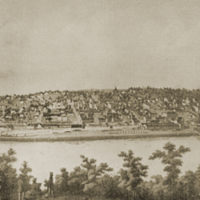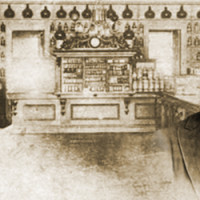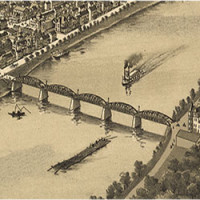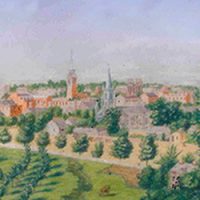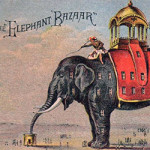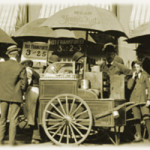
The brainchild of a German immigrant, New York’s Crystal Palace was built in the early 1850s as an exhibition hall. Inspired by London’s famous Crystal Palace in Hyde Park, entrepreneur and promoter Christian E. Detmold had a dream to erect a similar venue in the United States, where industrialists, scientists, artists, and visionaries could publicly exhibit their works, inventions, and technological innovations.
Approved for construction by New York City’ municipal authorities on January 3rd 1852, the notion of New York’s own Crystal Palace became a reality. Chosen to be built on the corner of 41st Street and Sixth Avenue, and just west of New York’s Croton Reservoir, municipal authorities granted developers a lease of land, which at the time served as a public square.
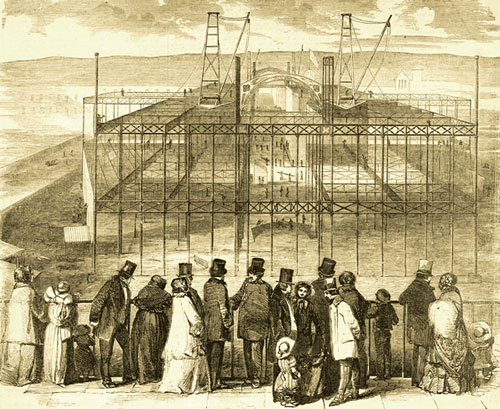
The square itself was a perfect spot, as it made for an easily accessible place to erect such a large and dramatic commercial venture. The Council agreed to its construction, just as long as the palace’s purveyors agreed to charge no more than 50-cents admission to the general public. The Council shared the entrepreneur’s vision, and more importantly, perceived its construction as a means to increase New York City’s worldly status.
The Crystal Palace took a mere 19 months from start to finish to construct, and upon its completion, was a mesmerizing architecture wonder.
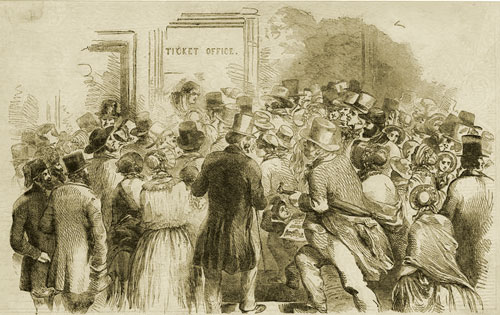
Made from glass and steel, its main building was topped with an enormous dome and flagpole, and featured an gigantic open-space atrium within its main entranceway.
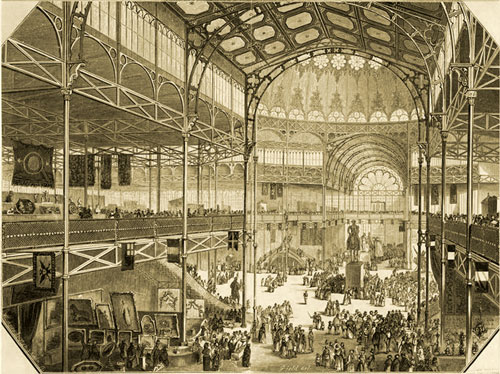
Visible for blocks around, the Crystal Palace complex featured other buildings as well. Standing 315 feet tall, the Latting Observatory was build next to it. Taller than Trinity Church, for its time the tower was the highest man-made building in the New York City.
Octagonal in shape and constructed of wood and iron, the tower featured an observation deck, where curious venue-goers could climb atop and gaze unobstructed at the city below, and its surrounding boroughs in the distance.

As a venue whose purpose was to awe-inspire the public, there were no shortage of curiosities, inventions, shows, and exhibits. At its inception there were over four thousand exhibitors, displaying the nation’s innovations, industrial achievements, and artwork.
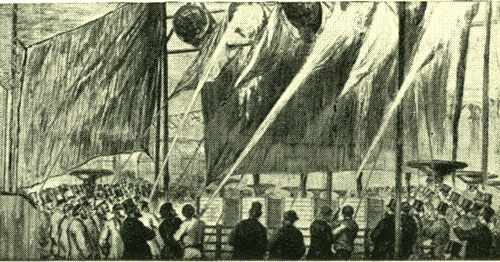
Like an ancestral EPCOT, the palace also featured themed wings and floors, dedicated to showcasing the wares and wonderments from countries throughout the world.
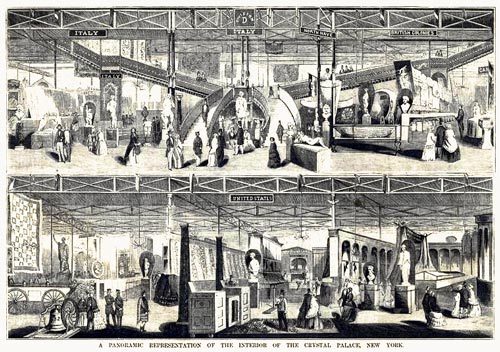
In addition to its purpose of showcasing wonderments, the building also hosted important celebrations, festivals, and even visiting dignitaries. The Czar of Russia, as well as Napoleon II made visits.
The Crystal Palace was also a windfall for savvy merchants and businessmen. In addition to its exposition offerings, it also housed shops, stores, and kiosks throughout. Not much different than a modern shopping mall, visitors could stroll through the complex, window-shop, and explore various wares that were offered for sale.

Unfortunately, popularity for the Crystal Palace waned almost as fast as it was born. Within a year after its opening, the venue began to experience a significant drop in interest, and most of the public’s excitement about the palace had withered.
Stewardship of the palace changed in 1854. P.T. Barnum, the famous New York showman, took the leadership role in its promotion and management.
Launching a new ‘Reinauguration,’ the public’s curiosity once again spiked. And for another short time, the venue appeared to have a future. However, its second birth and life was even more short-lived.
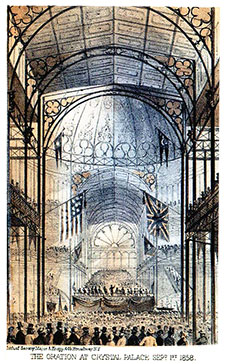
Despite the beauty and wonderment of the Crystal Palace, by the end of 1856 interest in the property had once again plummeted.
Indeed, its popularity by the public plunged so deeply, that by the end of 1856 it was declared a ‘dead’ property by popular newspapers.
Over the next year and half, the Crystal Palace limped along. Its once bountiful numbers of exhibitions had evaporated, and all but only a few merchants remained.
One of the last major events at the palace was the Atlantic Cable celebration.
Occurring on September 1, 1858, the festival was packed with revelers, and was held as a celebration of the first telegraph cabling across the Atlantic Ocean.
On October 5th 1858 without warning, the entire property became an inferno. Residents from all over New York City came to the palace, and stood by in astonishment, as the property conflagrated. Within hours the beautiful complex made of glass and steel had burned to the ground. At its final end, all that remained was a twisted skeleton of steel and ashes.

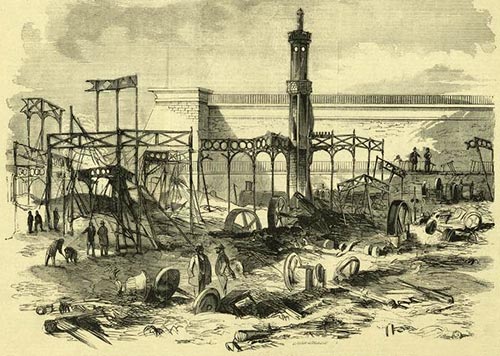
A public enquiry was undertaken to determine the cause of the firestorm. Its source had been found to be a service shed loaded with spare lumber that had caught fire. However, given that the venue was constructed mainly of glass and steel, the enquiry found it quite implausible that the entire structure would burn so quickly and completely to the ground.
Although never fully substantiated, it was summarily assumed that the cause of the fire was arson, aided with the help of accelerants.
The site of the Crystal Palace later became ‘Bryant Park.’
Numismatic Specimens
Below please find two merchant cards. Among the thousands of showman and exhibitors who were featured at the Crystal Palace, the specimens below advertised H.B. West’s troupe of trained dogs named ‘Tray’ and ‘Troy.’
Clearly a promotional piece, it is undetermined whether these emissions actually served as tenderable tokens for the public. Like other tokens of the day, it is certainly plausible that the token was used as an admission check for an act or a show.
The first specimen is catalogued as Miller NY-949. Struck in brass, and measuring 29mm in diameter, the specimen possesses a reeded-edge. It is Mint State in grade. Although Rulau lists no rarity for this specimen, I estimate that it is approximately R-2 using the Fuld Rarity Scale. Though quite uncommon in this grade, lesser grade specimens can be readily attained.
The second specimen is an unlisted variety. Similar to Miller NY-949, the specimen does not possess a reeded-edge. Rather, it possesses a plain edge like the silvered-brass Miller NY-949A. It is plausible that this specimen was struck with the intention of being silvered, but ultimately was not. It is approximately AU-58 in grade. Given that Miller nor Rulau list this specific variety, I estimate that the specimen is approximately R-8 on the Fuld Rarity Scale.
Aaron Packard ![]()
Notes and Sources
-
‘New York Crystal Palace; A Famous Enterprise Recalled by the Death of Its Chief Promoter,’ The New York Times, July 5, 1887
-
‘Other Burned Theatres,’ The New York Times, December 7, 1876
-
‘Bryant Park History,’ The Bryant Park Corporation
-
Appletons’ Cyclopædia of American Biography, William Ludwig Detmold, 1900
-
Standard Catalog of United States Tokens 1700-1900 Fourth Edition, Russell Rulau, Krause Publications, ©2004
-
The New York Public Library Digital Archives
-
The Library of Congress Digital Archives
- New York’s Crystal Palace & The H.B. West Tokens - November 6, 2019
- Edward Aschermann’s Cigar & Tobacco Tokens - November 2, 2019
- George T. Hussey & His Special Message Tokens - October 30, 2019



